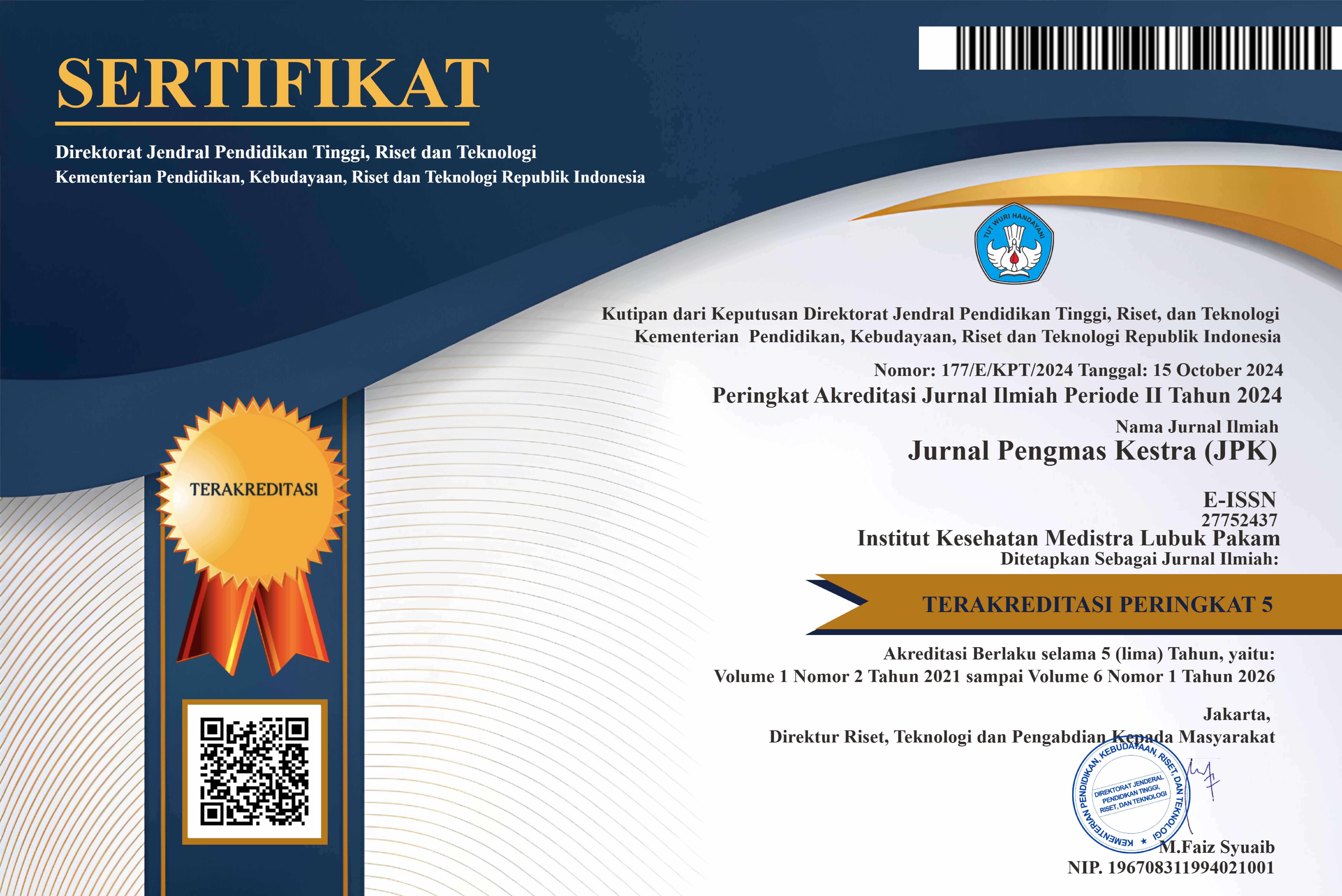SEMINAR IDENTIFIKASI BAKTERI ESCHERICHIA COLI O157:H7 PADA FESES PENDERITA DIARE DENGAN METODE KULTUR DAN PCR
DOI:
https://doi.org/10.35451/jpk.v1i1.746Keywords:
Escherichia coli O157:H7, PCR, CultureAbstract
The technique of identifying Escherichia coli O157: H7 bacteria in the feces of diarrhea sufferers using a molecular method, namely PCR has been proven to be more sensitive and shows fast results but is expensive when compared to conventional methods. Therefore, it can be recommended and used by health workers in early detection so that it will help make the diagnosis faster and determine treatment more effectively. The results of this seminar aim to make it easier for laboratory staff to identify the Escherichia coli O157: H7 bacteria in diarrhea sufferers.
References
Bakri Z; Hatta M; Nasrum M. 2010. Deteksi Keberadaan Bakteri Escherichia coli O157:H7 pada Feses penderita diare dengan Metode Kultur dan PCR. JST Kesehatan; (5), 2:184-192
Brooks GF, Butel JS, Morse SA (2005). Mikrobiologi Kedokteran Jawetz, Melnick, dan Adelberg. Edi Nugroho (alih bahasa). Jakarta : Salemba Medika
Dutta T.K., Roychoudhury S.P., Bandyopadhyay Wani S.A., and I. Hussain. (2011). Detection and characterization of Shiga toxin producing Escherichia coli (STEC) & enteropathogenic Escherichia coli (EPEC) in poultry birds with diarrhoea. Indian J. Med. Res. Vol 133, hal: 541-545.
Elliott T, Worthington T, Osman H, Gill M (2013). Mikrobiologi Kedokteran & Infeksi Edisi 4. Jakarta : EGC
Hermayudi dan Ayu, P.A. (2017). Penyakit daerah tropis. Yogyakarta: 2017.
Hidayatu W., Temaja I.G.R.M., dan Fatmawati N.N.D. (2018). Karakteristik Fenotip Isolat Klinik Escherichia coli O157:H7 Pada Media Sorbitol Mac Conkey Agar (SMAC). J. Agric.Sci. and Biotechnol. Vol 7 (1).
Jaipah N, Saraswati I, Hapsari R (2017). Uji Efektifitas Antimikroba Ekstrak Biji Pepaya (Carica Papaya L.) Terhadap Pertumbuhan Escherichia coli Secara In Vitro. Jurnal Kedokteran Diponegoro, ISSN : 2540 − 8844, 6 (2)
Jawetz, M. A. (2010). Mikrobiologi Kedokteran. (25 ed). (G. F. Brooks, K. C. Carroll, J. S. Butel, S. A. Morse, T. A. Mietzner, Penyunt, A. W. Nugroho, D. Ramadhani, H. Santasa, N. Yasdelita, & K. W. Nimala, penerj). New York: Mc Graw Hill.
Jayanti, D. D. (2018) ‘Deteksi Escherichia colo O157 Pada berbagai Air Minum di Kelurahan Sekaran Gunung Pati Semarang’. Universitas Negeri Semarang
Morin NJ, Gong Z & Li XF. 2004. Reverse Transcription-Multiplex PCR Assay for Simultaneous Detection of Escherichia coli O157: H7, Vibrio cholerae OI, and Salmonella Typhi. Clinical Chemistry. 50(11): 2037-2044.
Peter C.H., Councell F.T., Keys C., and Monday S.R. (2011). Virulence characterization of Shiga-toxigenic Escherichia coli isolates from wholesale produce. Appl. Environ. Microbiol. Vol 77 (1), hal: 343-345.
Rananda RM, Djamal A, Julizar. 2016. Identifikasi Bakteri Escherichia coli O157:H7 dalam Daging Sapi yang Berasal Dari Rumah Potong Hewan Lubuk Buaya. Jurnal Kesehatan Andalas 5(3): 614-617
Rizky, V. A. (2018) ‘Perbedaan Jumlah Koloni Bakteri Escherichia coli Pada Penanaman Menggunakan Teknik Sengkelit (calibrated loop) dan Mikropipet (pipet dilution method) Metode Spread plate’. UKMC Palembang
Sartika, Indrawani, dan Sudiarti. (2005). Analisis Mikrobiologi Escherichia coli O157:H7 Pada Hasil Olahan Hewan Sapi Dalam Proses Produksinya. Jurnal Makara Kesehatan, Vol 9 No (1), Hal 23-28.
Vos, P. et al. (2009). Bergey’s Manual of Systematic Bacteriology. 2nd edn, Springer-Verlag New York. 2nd edn. Springer-Verlag New York. doi: 10.1007/978-0-387-68489-5.
Downloads
Published
Issue
Section
License
Copyright in each article is the property of the Author.




















